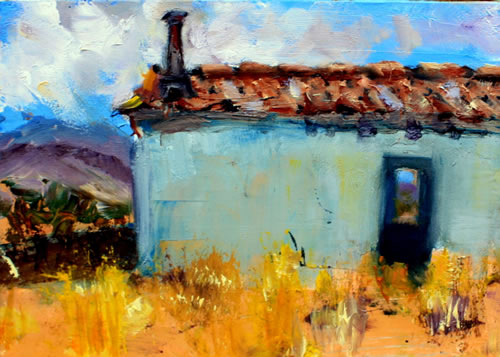











"I find inspiration for my figurative paintings in any number of places, from a casual comment to a song. I try not to be too specific in the narrative so the viewer can complete the story and the emotion, so they can have their own relationship with the painting. The artist can capture an expression or an idea and share a moment in time, and at the same time the goal is to subordinate technique to the design of the subject - to leave no residue of technical mannerisms to stand between my expression and the observer." ~ Sue Nichols
There has been much speculation and debate as to the origins of the name La Luz, which in Spanish means "the light". Maybe the name comes from the warm colors presented in the evening or as some have said it originated with a signaling system used by early settlers with the village of Tularosa, or the Mescalero using fires to scare the settlers and possibly the wildest, that the lights are some type of UFO phenomenon.
We do know that early maps that predate the founding of the village occurred. The Garcia family and other families fled from floods that devastated villages and farms along the Rio Grande near present day Socorro, New Mexico. An acequia or ditch system was developed early on to irragate crops and orchards and a presidio or fort was built out of adobe where the present day Parue de Presidio is located to prevent raids by the Apache.
The village soon became a stop for the stage coach and other travelers on their way to Ft. Stanton or other areas. By the 1880's Anglo settlers started moving into the area homesteading in the high elevatios of the Sacremento Mountains and some started cattle operations. Cowboys, including the famous outlaw Billy the Kid, were known to stop over in La Luz on their travels.
In 1898 the Industrial Revolution came to La Luz in the form of the railroad and the town of Alamogordo along with it was built just a few miles south. The establishment of the railroad and the industry it brought increased population and brought many newcomers. La Luz would also see increased development from individuals coming from the East.
Today as one can see in the paintings in this collection this area is rich in history and culture reflective of the early time of settlement.
There has been much speculation and debate as to the origins of the name La Luz, which in Spanish means "the light". Maybe the name comes from the warm colors presented in the evening or as some have said it originated with a signaling system used by early settlers with the village of Tularosa, or the Mescalero using fires to scare the settlers and possibly the wildest, that the lights are some type of UFO phenomenon.
We do know that early maps that predate the founding of the village occurred. The Garcia family and other families fled from floods that devastated villages and farms along the Rio Grande near present day Socorro, New Mexico. An acequia or ditch system was developed early on to irragate crops and orchards and a presidio or fort was built out of adobe where the present day Parue de Presidio is located to prevent raids by the Apache.
The village soon became a stop for the stage coach and other travelers on their way to Ft. Stanton or other areas. By the 1880's Anglo settlers started moving into the area homesteading in the high elevatios of the Sacremento Mountains and some started cattle operations. Cowboys, including the famous outlaw Billy the Kid, were known to stop over in La Luz on their travels.
In 1898 the Industrial Revolution came to La Luz in the form of the railroad and the town of Alamogordo along with it was built just a few miles south. The establishment of the railroad and the industry it brought increased population and brought many newcomers. La Luz would also see increased development from individuals coming from the East.
Today as one can see in the paintings in this collection this area is rich in history and culture reflective of the early time of settlement.